Tab.1 XLPE aging temperature and aging time

老化温度/℃老化时间/h 1400, 120, 360, 720 1600, 48, 168, 240 1800, 24, 36, 48
摘要 高压电缆的运行温度是影响其绝缘性能的关键因素。该文通过对交联聚乙烯(XLPE)开展不同温度下的加速热老化实验,对比了XLPE微观理化性能和宏观电学性能的变化规律。同时,在微观层面模拟了XLPE分子在不同温度下自由体积与均方位移的变化规律,在宏观层面结合XLPE的介电性能分析了高压电缆内部温度场的变化规律,进而揭示了高温下高压电缆的绝缘失效机理。研究结果表明,随着老化温度的升高,XLPE分子的劣化程度加快,羰基、碳碳双键等官能团含量增大;介质损耗因数与介电常数逐渐增加,甚至出现了突增的现象;结晶区结构的被破坏加快了击穿场强的下降;分子运动加剧,自由体积率从12.53%增大至14.07%。老化后介电性能的下降会导致电缆内部温度升高,从而对电缆的热老化起到了正反馈作用。
关键词:高压电缆 热老化 交联聚乙烯 仿真分析
交联聚乙烯(Cross-Linked Polyethylene, XLPE)高压电缆凭借其优异的电学性能与理化性能广泛应用于高压输电工程[1-4]。随着电力消费和电力生产需求的增长,以及高压电缆电压等级和载流量的提升,电缆线芯的温度不断升高[5-7],由此引发的高温热老化问题不容小觑。
高压电缆的热老化问题是影响电缆安全运行的关键因素之一[8-10]。目前,对于高压电缆热老化问题的研究相对广泛,主要包括老化前后微观形貌变化、结晶度改变、介电性能对比等[11-13]。文献[14]通过对XLPE进行加速热老化实验,研究发现了XLPE的热伸长率及其微观网络结构与抗氧性能有关。文献[15]采用不同热老化温度测试分析了XLPE电学特性的变化,结果表明温度越高,XLPE的体积电阻率下降得越快。文献[16]研究了热老化对XLPE电缆绝缘层中电树枝生长的影响,发现电树枝平均起始电压是由于老化过程中的重结晶现象引起的。文献[17]针对电缆发热问题,研究了不同电压等级下绝缘层中的电场分布,结果表明电压等级的提升导致绝缘层中的介电常数与介质损耗逐渐增大。早在1930年,V. M. Montsinger[18]证实了高压电缆的运行温度每升高8~10℃,电缆的使用寿命就缩短一半。高压电缆在运行过程中温度的变化并不稳定,尤其是在发生短路故障时,导体的温度可高达250℃。在前期的研究中[19],仅探究了XLPE电缆绝缘的寿命变化,并未分析不同热老化温度下XLPE性能的变化,尤其是涉及寿命失效点之后的对比研究。同时不同老化温度引起的电缆绝缘性能尚不完全清楚,高温下的电缆绝缘失效机理有待深入研究。
本文通过制备高压电缆绝缘层试样,对高压电缆进行加速热老化实验,对比不同温度下电缆绝缘层官能团、介电常数、介质损耗因数、击穿场强的变化规律;同时,结合XLPE微观分子运动特性与电缆内部温度场变化,揭示高压电缆绝缘的失效机理。因此,开展此项工作可为高压电缆在不同环境下的绝缘状态分析提供参考依据与理论指导。
采用商用高压电缆绝缘料制备XLPE老化试样。首先,将绝缘料置于干燥箱中进行干燥化处理;其次,将绝缘料置于130℃平板硫化机下预热6 min;再次,在180℃下加压10 min,制取厚度为0.3 mm左右的绝缘层试样。根据标准IEC 60216,将试样置于热老化烘箱中,常用的加速老化温度在110~ 180℃范围内[20],为了将老化实验的时间和成本控制在可以接受的范围内,老化温度与老化时间的设置见表1。本文选用140℃、160℃和180℃三个温度进行XLPE加速热老化实验。
表1 XLPE老化温度和老化时间
Tab.1 XLPE aging temperature and aging time

老化温度/℃老化时间/h 1400, 120, 360, 720 1600, 48, 168, 240 1800, 24, 36, 48
1.2.1 官能团测试
采用傅里叶变换红外光谱(Fourier Transform Infrared spectroscopy, FTIR)对比分析了不同老化温度下XLPE老化试样的官能团变化规律。实验前将试样置于60℃烘箱中2 h,除去试样中的水分。扫描波数设为4 000~500 cm-1。
1.2.2 介电性能测试
用宽频介电谱仪测试不同老化温度下XLPE试样的介电常数与介质损耗因数。为了保证金属电极与试样接触的良好性,测试前在试样表面蒸镀一层金属铝薄膜。测试频率设为10-1~106 Hz,测试电压设为1 V,圆形试样的直径为25 mm、厚度为1 mm。
1.2.3 击穿场强测试
采用高压击穿测试仪,测试不同老化时间下的击穿场强。根据标准,采用圆柱形电极,电极直径为25 mm,为了避免发生闪络现象。采用硅油作为液体介质,试样厚度为0.3 mm,采用交流升压方式,升压速率为500 kV/s。实验数据采用Weibull分布下的积累击穿概率进行分析,其表达式为
 (1)
(1)
式中,i为试样的序号;n为试样的样本总容量;F(i,n)为XLPE老化试样击穿场强从小到大排列后的计算结果。
采用FTIR可以分析老化引起的官能团变化。不同老化温度下XLPE的官能团变化规律如图1所示。从图1中可以看出,未发生老化时XLPE的官能团主要位于2 915、2 847、1 462、719 cm-1附近,分别对应亚甲基对称伸缩吸收峰、不对称伸缩吸收峰、弯曲变形吸收峰、面内摇摆变形吸收峰。在高温老化后,XLPE变化明显的官能团以羰基、碳碳双键为主,分别在1 735~1 725 cm-1、1 600~1 595 cm-1附近;同时,在1 181 cm-1附近醚基官能团的含量也出现了增大。XLPE热氧老化反应示意图如图2所示。从图2中可以看出,XLPE分子链在氧气的作用下促使碳氢键发生了断裂,氧原子与碳原子结合形成碳氧单键,同时游离的氢原子与氧原子结合形成过氧化氢游离基。随着老化程度的加剧,碳氧单键形成碳氧双键,构成羰基基团;与此同时,部分碳碳键也发生了断链,在碳碳键断裂处形成自由基,部分自由基之间发生脱氢反应,生成碳碳双键[21]。因此,随着老化时间的增加,不同老化温度下的XLPE会累积较多的羰基、碳碳双键等具有极性的官能团。

图1 不同老化温度下XLPE官能团变化规律
Fig.1 Changes in functional groups of XLPE at different aging temperatures
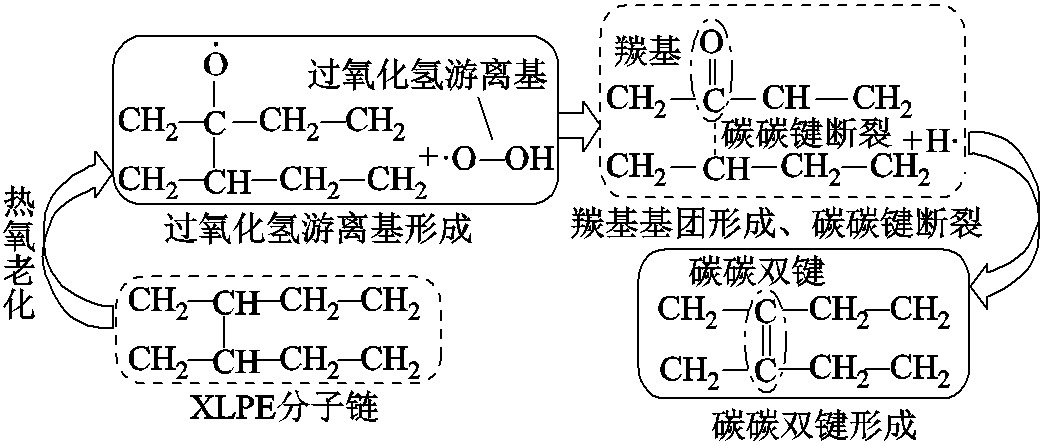
图2 XLPE热氧老化反应示意图
Fig.2 Schematic diagram of XLPE thermo-oxidative aging reaction
为了定量地描述不同老化温度下羰基与碳碳双键含量随老化时间的变化规律,分别计算了羰基指数与碳碳双键指数,计算式为
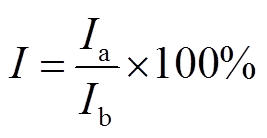 (2)
(2)
式中,I为官能团指数;Ia为羰基或碳碳双键所处位置的峰强;Ib为未老化时2 915 cm-1附近亚甲基峰的强度。
不同老化温度下XLPE的羰基指数、碳碳双键指数随着老化时间的变化规律如图3所示。由图3可知,随着老化时间的延长,羰基指数与碳碳双键指数均逐渐增大,且老化温度越高,增大的速度越快。当老化温度为160℃时,羰基指数与碳碳双键指数出现了突增,这是因为老化温度较高、老化时间较长,高压电缆绝缘层性能已经超过了寿命的失效点时性能的临界值,极性基团的含量迅速增大。未老化时羰基指数与碳碳双键指数分别为0.06与0.07,这是因为XLPE绝缘层在制备中具有热历史过程,发生了氧化反应,可以忽略不计。当140℃老化720 h后,羰基指数与碳碳双键的指数分别为0.29、0.27;当160℃老化240 h后羰基指数与碳碳双键的指数分别为2.48、0.41;当180℃老化48 h后羰基指数与碳碳双键的指数分别为0.31、0.89。
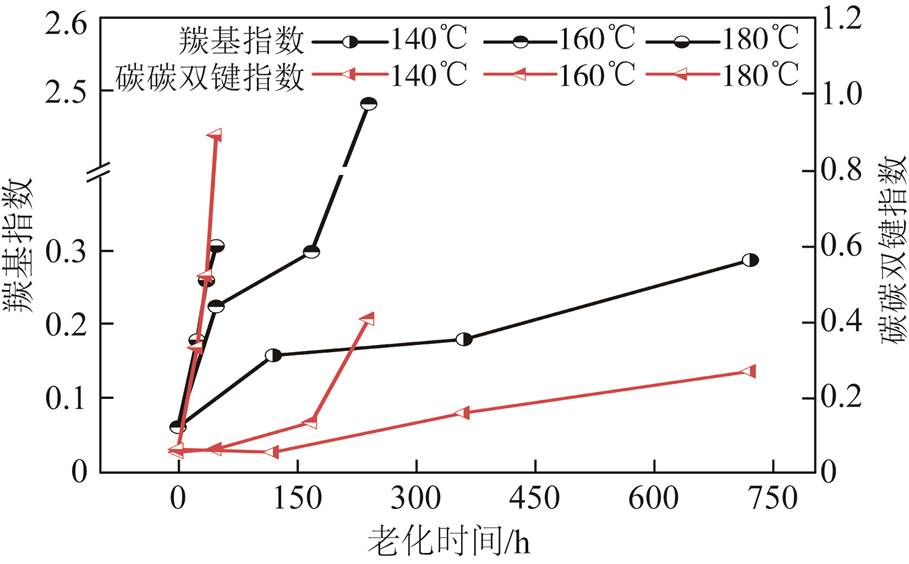
图3 不同老化温度下羰基指数、碳碳双键指数变化规律
Fig.3 Carbonyl index and carbon-carbon double bond index at different aging temperatures
不同老化温度下XLPE介电常数的变化规律如图4所示(本文所讨论的介电常数均为相对值)。从图4a中可以发现,老化温度为140℃时,XLPE的介电常数随着老化时间的延长逐渐增大,但是随着频率的增大,介电常数基本保持一致。从图4b和图4c可以看出,在160℃与180℃老化温度下,XLPE介电常数随着老化时间的增大逐渐增大。介电常数表征了XLPE的分子极化能力,老化时间越长,XLPE的极化能力越强。这是因为在老化的过程中XLPE分子链发生了断裂,在氧气的作用下断裂的分子链与氧气结合生成具有极性的羰基、醚基等官能团,提高了XLPE的极化能力。当老化温度为140℃时,XLPE的介电常数基本不随频率变化而发生改变,但是当老化温度为160℃和180℃时,介电常数随着频率的增大出现了逐渐下降的趋势,尤其是在老化温度为180℃时。这是因为XLPE是非极性介质,其介电常数基本不随着频率的增加而发生变化,因此在未老化时XLPE的介电常数维持在2.29附近。当老化温度为180℃时,由于老化温度较高,XLPE在较短的时间发生劣化,内部产生了较多的极性基团,影响了自身的极化强度。随着频率的增加,内部极性基团发生极化的速率滞后于频率的改变,极化能力减弱,介电常数下降。
以50 Hz为例,提取了不同老化温度下的介电常数进行对比。从图4中可以看出,老化温度越高,介电常数增加的幅值就越大。50 Hz下,未老化时XLPE的介电常数为2.29;当老化温度为140℃时,老化720 h后介电常数为2.97,增大了29.69%;当老化温度为160℃时,老化240 h后介电常数为4.0,增大了74.67%;当老化温度为180℃时,老化48 h后介电常数为4.03,增大了75.98%。
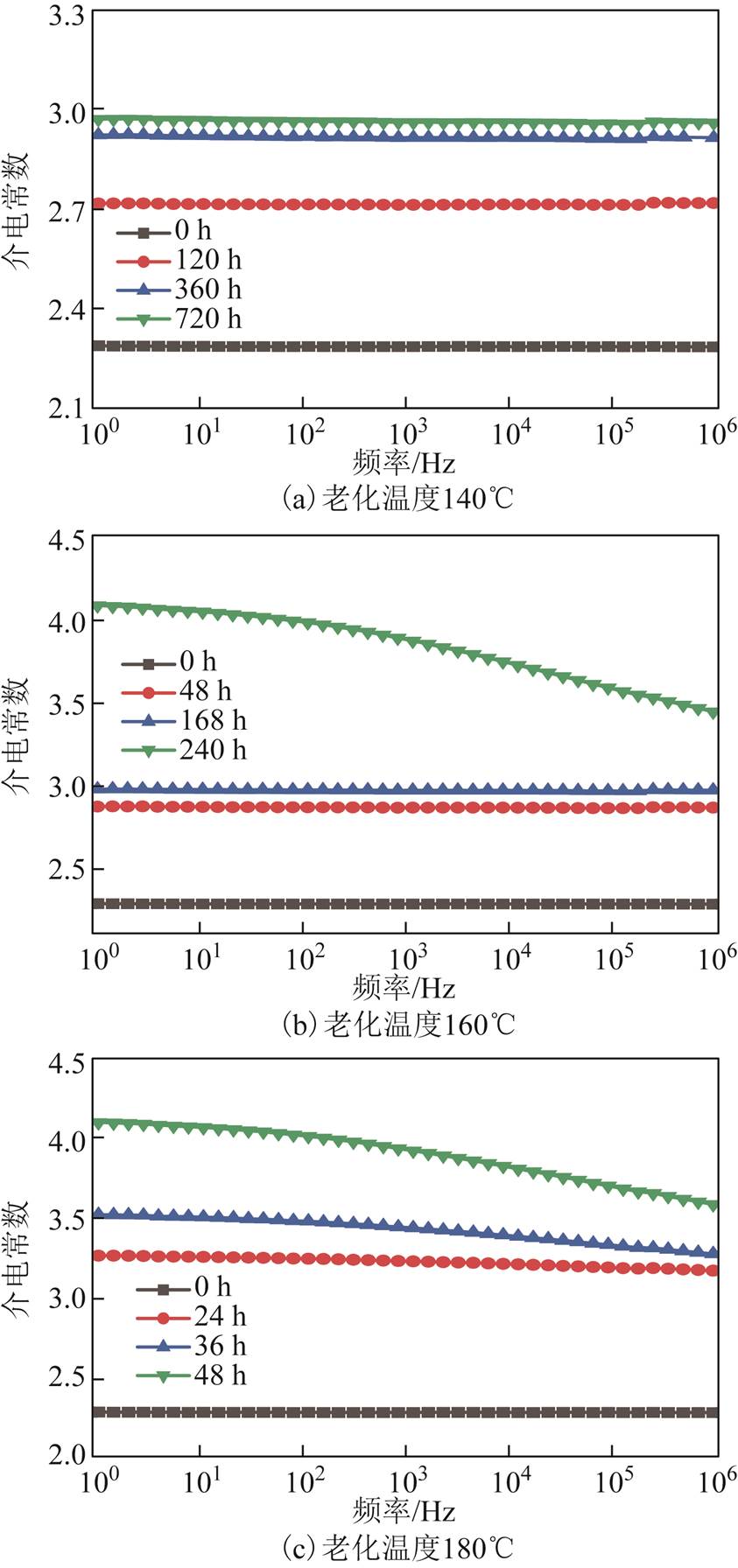
图4 不同老化温度下XLPE的介电常数
Fig.4 The dielectric constant of XLPE at different aging temperatures
不同老化温度下XLPE的介质损耗因数变化规律如图5所示。从图5中可以看出,不同温度下介质损耗因数的变化规律基本保持一致,即随着老化温度的升高,介质损耗因数逐渐增大;但是同一老化时间下介质损耗因数的变化规律与频率的高低密切相关。对于未老化时的XLPE,其介质损耗因数随着频率的增大略微增大。当160℃老化240 h时,介质损耗因数突然增大,这与XLPE老化到达失效点临界值有关。根据XLPE官能团变化规律可知,羰基、醚基含量的突然增大,导致内部极性基团的含量增大,因此产生的极化损耗就出现了突增的现象。当老化温度为180℃时,介质损耗因数随着频率的增大出现了明显的增大趋势。在低频时,XLPE内部大量的极化粒子发生的转向极化可以跟随频率的变化,因此介质损耗较低;在高频时,极化粒子远远滞后于频率的变化,因此单位体积内大量的极化粒子产生的介质损耗增大。
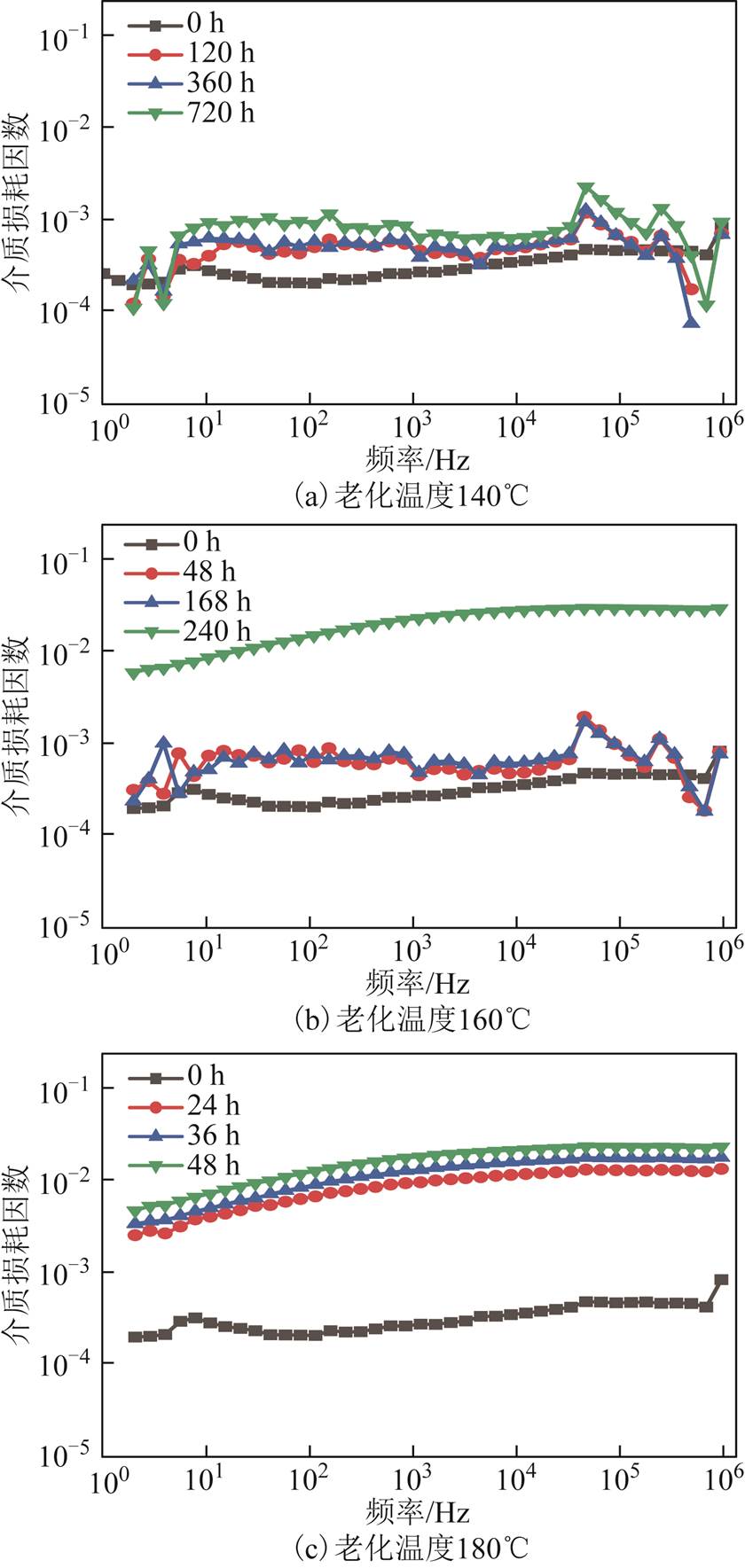
图5 不同老化温度下XLPE介质损耗因数变化规律
Fig.5 Changes in XLPE dielectric loss factor under different aging temperatures
同样以50 Hz为例,提取了不同老化温度下的介质损耗因数进行对比。从图5中可以发现,老化温度相对较低时介质损耗因数缓慢增加;老化温度较高时介质损耗因数迅速增大。未老化时,XLPE介质损耗因数为2.00×10-4,140℃老化720 h后介质损耗因数达到8.72× 10-4;160℃老化240 h后介质损耗因数高达1.24×10-2;180℃老化48 h后介质损耗因数迅速达到1.05×10-2。
不同老化温度下XLPE试样的击穿场强变化规律如图6所示。从图6中可以看出,每种老化温度下XLPE击穿场强的变化规律保持一致,即随着老化时间的增加,击穿场强呈现出下降的趋势。未老化时XLPE击穿场强为80.42 kV/mm;当140℃老化720 h后击穿场强为62.42 kV/mm,下降了22.38%;当160℃老化240 h后击穿场强为52.73 kV/mm,下降了34.43%;当180℃老化48 h后击穿场强为53.73 kV/mm,下降了33.19%。根据击穿场强的变化规律可以发现,老化温度越高,XLPE的击穿场强下降得越快。XLPE在老化的过程中由分子链断裂生成的羰基、醚基等具有极性的官能团作为杂质粒子会影响XLPE内部电场的分布,产生畸变电场,导致XLPE发生击穿。作为半结晶性介质,XLPE内部结构由结晶区与无定型区构成。研究表明,在热老化的过程中XLPE结晶度会出现下降的趋势,宏观的电学现象与结晶程度紧密相关[13,22-24]。因此,高温老化破坏了致密的结晶区结构,导致电子的自由行程增大,为击穿的发生提供了可能。

图6 不同老化温度下XLPE的击穿场强
Fig.6 Breakdown field strength of XLPE at different aging temperatures
高压电缆绝缘老化是微观-宏观层面共同作用的结果,主要体现在官能团的增加,介电常数、介质损耗的增大,击穿场强的下降等方面。为了探究微观-宏观变化对高压电缆绝缘失效的影响,分别采用分子模拟、有限元仿真等方法,揭示高压电缆绝缘的失效机理。
在量子力学的基础上采用分子模拟软件构建XLPE分子对其进行分子动力学模拟[25-27]。XLPE作为三维立体网状分子结构,聚合度较大,为了减小仿真过程中的复杂度,简化XLPE分子模型,构建了H型XLPE分子链如图7a所示。采用硬球探针方法计算自由体积,借助自由体积变化率和均方位移的变化规律分析XLPE分子在不同温度下的微观运动对其宏观电学特性的影响。其中,自由体积率是自由体积与总体积的比值。为了保证结果的合理性,首先对构建的XLPE分子模型进行优化处理,具体参数设置见表2。表中,1 Ha=27.211 4 eV;1 Å =1×10-10 m。

图7 XLPE分子结构
Fig.7 Molecular structure of XLPE
表2 XLPE模型优化参数设置
Tab.2 XLPE model optimisation parameter settings

参数数值 能量变化/Ha2.0×10-5 最大力/(Ha/Å)<0.004 最大位移/Å<0.005 迭代步数200
图7b为XLPE分子的自由体积模型,可以看出,XLPE分子分布在晶胞系统中,主要由XLPE分子链与自由体积组成。不同老化温度下XLPE分子的自由体积率变化规律如图8所示。从图8中可以看出,当温度为140℃、160℃、180℃时,XLPE的自由体积率分别为12.53%、13.40%、14.07%。老化温度越高,XLPE分子的自由体积越大。XLPE分子自由体积的增大会导致内部电子自由移动的空间增大,电子移动的阻力下降,电子动能增大,加剧了对分子链的破坏程度,因此XLPE分子自由体积的增大导致了击穿场强的下降。
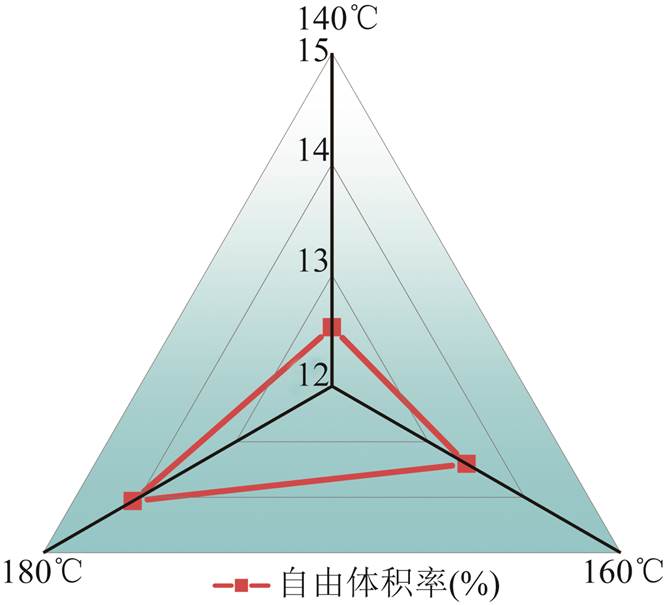
图8 不同温度下XLPE自由体积率
Fig.8 XLPE free volume rate at different temperatures
不同温度下XLPE的均方位移变化规律如图9所示。均方位移随着时间的延长逐渐增大,表明XLPE分子链整体运动能力增强。同时,随着温度的升高,均方位移逐渐增大。以2 000 ps为例,140℃、160℃、180℃时的均方位移分别为22.43 Å2、26.57 Å2、44.77 Å2。与140℃相比,180℃时的均方位移增大了99.96%。均方位移的增大表明温度的升高加快了分子的运动能力,分子链之间受力加剧,从而加快了分子链的断裂。
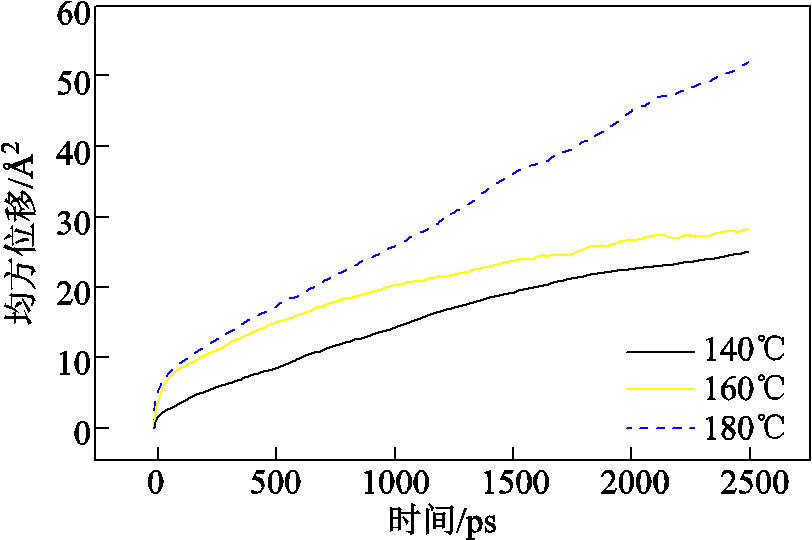
图9 不同老化温度下XLPE分子均方位移变化规律
Fig.9 Changes of XLPE molecular mean square displacement at different temperatures
高压电缆内部温度场的变化对绝缘层宏观-微观性能影响较大[28],是导致绝缘层发生热老化的根本原因。同时有研究表明,绝缘层介质损耗与介电常数会影响电缆的温度[29]。因此,本文结合XLPE在不同老化温度下介电常数与介质损耗的变化规律,利用有限元仿真软件,对不同老化状态下高压电缆内部温度变化的情况进行了分析。
高压电缆是由多层结构组成的绝缘系统,主要包括铜导体、半导电层、绝缘层等。为了降低仿真过程中的复杂性,建立了高压电缆简化模型,如图10所示。在进行高压电缆内部温度场仿真分析时,电缆内部各层结构的热物理参数设置见表3。电缆的载流量设置为1 400 A[30],导体初始温度设置为25℃。
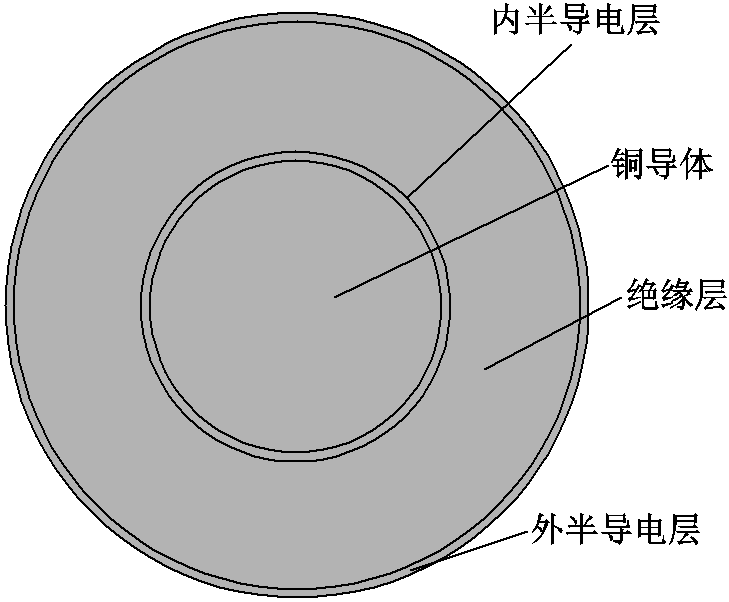
图10 高压电缆简化模型
Fig. 10 Simplified model of high voltage cable
表3 高压电缆结构简化模型热物理参数
Tab.3 Thermal physical parameters of simplified model of high voltage cable structure

电缆结构比热容/[J/(kg·K)]密度/(kg/m3)热导率/[W/(m·K)] 铜导体3868 900398 内半导电层1 6001 0000.65 绝缘层2 3009500.3 外半导电层1 6001 0000.65
根据固体传热原理,高压电缆内部温度场变化所涉及的物理方程为
 (3)
(3)
式中,dZ为厚度;k为热导率;ρ为密度;c为比热容;Q为热源; 为热弹性阻尼;
为热弹性阻尼; 为热流密度;u为位移;T为材料某一位置温度。
为热流密度;u为位移;T为材料某一位置温度。
高压电缆的发热主要来源于导体损耗和绝缘损耗。研究表明[31],电缆发生老化后介质损耗与介电常数会对电缆线芯温度产生一定的影响。高压电缆在未发生高温热老化时的温度场如图11a所示。从图11a中可以看出,高压电缆内部线芯温度最高为58.3℃,各层结构温度递减。分别采用140℃老化720 h、160℃老化240 h、180℃老化48 h的介电常数与介质损耗因数作为输入参数,模拟不同温度下电缆内部温度的变化,结果如图11b所示。从图11b中可以看到,介电常数与介质损耗因数的改变导致电缆内部的温度出现了升高。140℃老化720 h后电缆内部最高温度为62.2℃,最低温度为48.9℃;160℃老化240 h后电缆内部最高温度高达137℃,最低温度为103℃。由仿真结果可知,当高压电缆发生热老化后,高压电缆绝缘性能的下降会引起电缆老化出现正反馈的趋势,进而加快了电缆的老化速度。
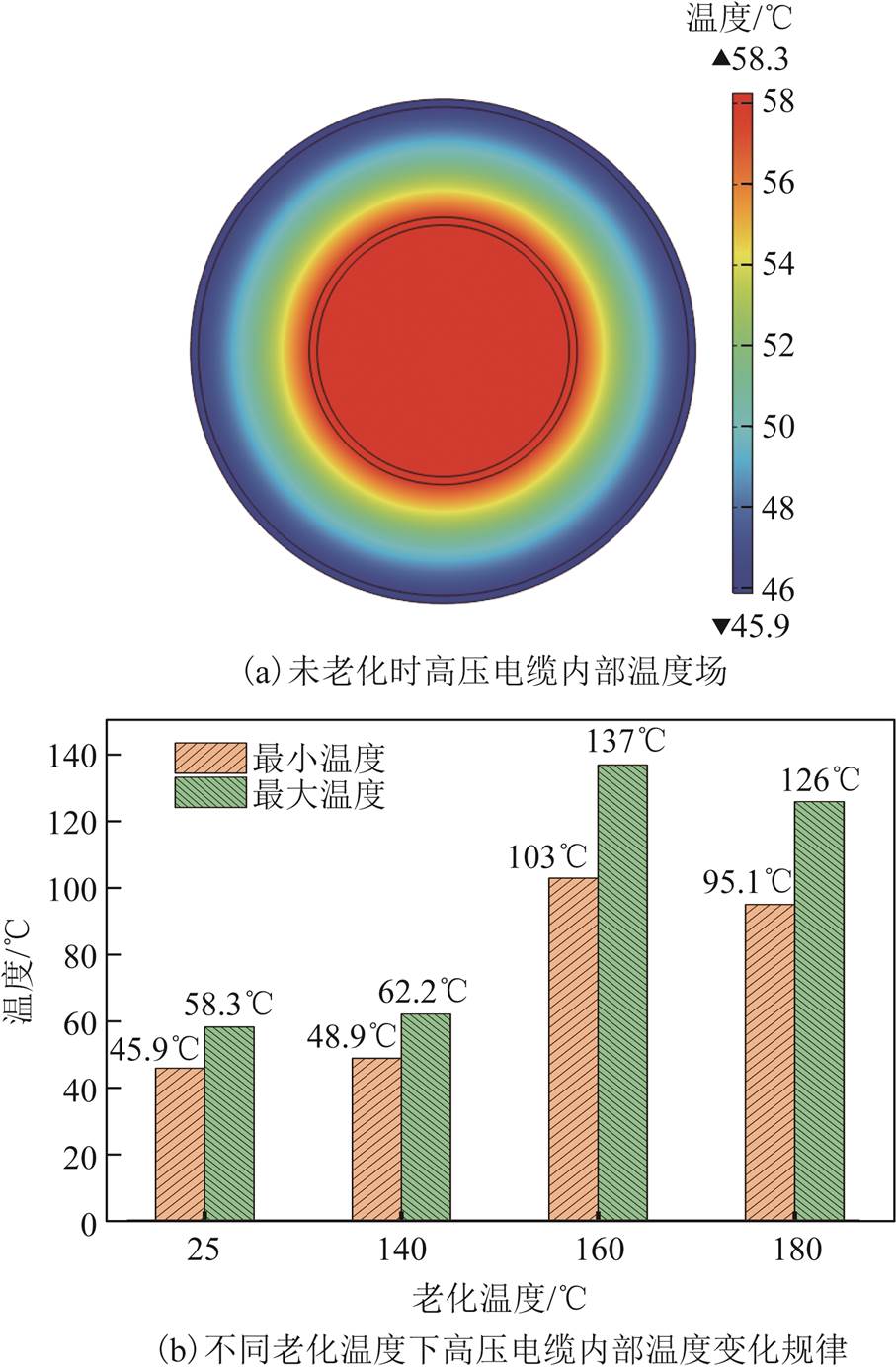
图11 高压电缆温度场分布
Fig.11 High voltage cable temperature field distribution
本文通过微观与宏观相结合的实验方法,分析了XLPE高压电缆在不同老化温度下的绝缘老化状态,结合仿真方法在微观层面分析了XLPE分子的运动情况,在宏观方面研究了高压电缆内部温度场的变化规律。主要得到以下结论:
1)官能团分析表明,XLPE高压电缆在加速热老化后会生成羰基、碳碳双键等新的官能团,老化温度越高,羰基与碳碳双键指数增加得越多。140℃老化720 h后XLPE的羰基指数与碳碳双键指数分别为0.29、0.27;160℃老化240 h后XLPE的羰基指数与碳碳双键的指数分别为2.48、0.41。
2)介电性能和击穿场强分析表明,在同一老化温度下,随着老化时间的延长,XLPE的介质损耗因数与介电常数逐渐增大;随着老化温度的升高,XLPE内部极性基团增加,导致介质损耗因数与介电常数随着频率的升高分别出现了增大与下降的趋势。XLPE击穿场强的下降较为明显。
3)分子模拟表明,随着温度的升高,XLPE分子的均方位移、自由体积率逐渐增大,从微观层面揭示了随着老化程度的增加,XLPE电学性能下降的原因。此外,不同老化温度下,介质损耗因数与介电常数的增大,会引起电缆线芯温度的升高,进而加快了绝缘热老化。
参考文献
[1] 王国栋, 周凯, 李原, 等. 基于失效时间统计特性的交联聚乙烯电寿命模型修正[J]. 电工技术学报, 2023, 38(4): 1042-1050. Wang Guodong, Zhou Kai, Li Yuan, et al. Modification of cross-linked polyethylene electrical life model based on statistical characteristics of failure time[J]. Transactions of China Electrotechnical Society, 2023, 38(4): 1042-1050.
[2] 吴晶晶, 陈丽安, 严有祥, 等. ±500 kV高压直流XLPE电缆温度分布及其影响因素研究[J]. 高压电器, 2023, 59(2): 113-119. Wu Jingjing, Chen Lian, Yan Youxiang, et al. Study on temperature distribution of ±500 kV HVDC XLPE cable and its influencing factors[J]. High Voltage Apparatus, 2023, 59(2): 113-119.
[3] 陈向荣, 洪泽林, 朱光宇, 等. 高温下电压稳定剂对交联聚乙烯电树枝化及局部放电特性的影响[J]. 电工技术学报, 2023, 38(3): 577-586. Chen Xiangrong, Hong Zelin, Zhu Guangyu, et al. Effect of voltage stabilizer on electrical treeing and partial discharge characteristics of crosslinked polyethylene at high temperature[J]. Transactions of China Electrotechnical Society, 2023, 38(3): 577-586.
[4] 王昊月, 王晓威, 孙茂伦, 等. XLPE电缆绝缘热老化的高压频域介电谱诊断方法[J]. 电工技术学报, 2022, 37(17): 4497-4507. Wang Haoyue, Wang Xiaowei, Sun Maolun, et al. High voltage frequency domain dielectric spectroscopy diagnosis method for thermal aging of XPLE cables[J]. Transactions of China Electrotechnical Society, 2022, 37(17): 4497-4507.
[5] Candela R, Gattuso A, Mitolo M, et al. A model for assessing the magnitude and distribution of sheath currents in medium and high-voltage cable lines[J]. IEEE Transactions on Industry Applications, 2020, 56(6): 6250-6257.
[6] 陈祎林, 周凯, 林思衍, 等. 短时高热运行对XLPE电缆绝缘聚集态结构及介电性能的影响[J]. 高电压技术, 2023, 49(2): 588-596. Chen Yilin, Zhou Kai, Lin Siyan, et al. Effect of short-term high-temperature operation on the aggregate structure and dielectric properties of XLPE cables insulation[J]. High Voltage Engineering, 2023, 49(2): 588-596.
[7] Wei Yanhui, Liu Mingyue, Li Xuejing, et al. Effect of temperature on electric-thermal properties of semi-conductive shielding layer and insulation layer for high-voltage cable[J]. High Voltage, 2021, 6(5): 805-812.
[8] 李盛涛, 王诗航, 杨柳青, 等. 高压电缆交联聚乙烯绝缘的关键性能与基础问题[J]. 中国电机工程学报, 2022, 42(11): 4247-4255. Li Shengtao, Wang Shihang, Yang Liuqing, et al. Important properties and fundamental issues of the crosslinked polyethylene insulating materials used in high-voltage cable[J]. Proceedings of the CSEE, 2022, 42(11): 4247-4255.
[9] 闫群民, 李欢, 翟双, 等. 不同温度热老化对高压配网交联聚乙烯电缆绝缘表面陷阱参数的影响[J]. 中国电机工程学报, 2020, 40(2): 692-701. Yan Qunmin, Li Huan, Zhai Shuang, et al. Effect of thermal aging at different temperatures on the surface trap parameters of HV-XLPE distribution cable insulation[J]. Proceedings of the CSEE, 2020, 40(2): 692-701.
[10] 康佳, 姜磊, 高景晖, 等. 漂浮式风电平台动态海缆用绝缘材料性能研究[J]. 高压电器, 2022, 58(1): 12-17. Kang Jia, Jiang Lei, Gao Jinghui, et al. Study on properties of insulating materials for dynamic submarine cable of floating wind power platform[J]. High Voltage Apparatus, 2022, 58(1): 12-17.
[11] 刘刚, 刘斯亮, 金尚儿, 等. 基于理、化、电特性的110 kV XLPE绝缘电缆剩余寿命的综合评估[J]. 电工技术学报, 2016, 31(12): 72-79, 107. Liu Gang, Liu Siliang, Jin Shanger, et al. Comprehensive evaluation of remaining life of 110kV XLPE insulated cable based on physical, chemical and electrical properties[J]. Transactions of China Electrotechnical Society, 2016, 31(12): 72-79, 107.
[12] Alghamdi A S, Desuqi R K. A study of expected lifetime of XLPE insulation cables working at elevated temperatures by applying accelerated thermal ageing[J]. Heliyon, 2020, 6(1): e03120.
[13] Yang Zhangyong, Li Huan, Duan Yilin, et al. Study on melting characteristics of crystals in thermal aged XLPE cable insulation at elevated temperature[J]. Journal of Materials Science: Materials in Electronics, 2021, 32(12): 16194-16202.
[14] Liu Hongjian, Wang Shihang, Li Shengtao, et al. Effect of thermo-oxidative aging on thermal elongation performance of XLPE insulation for high-voltage cables[J]. Polymer Degradation and Stability, 2023, 210: 110291.
[15] Boukezzi L, Boubakeur A. Effect of thermal aging on the electrical characteristics of XLPE for HV cables[J]. Transactions on Electrical and Electronic Materials, 2018, 19(5): 344-351.
[16] Zhang Yi, Wu Zaijun, He Jiahong, et al. Electrical treeing behaviours in cross-linked polyethylene cables after thermal ageing[J]. High Voltage, 2023, 8(4): 749-759.
[17] Nadolny Z. Electric field distribution and dielectric losses in XLPE insulation and semiconductor screens of high-voltage cables[J]. Energies, 2022, 15(13): 4692.
[18] Montsinger V M. Loading transformers by temperature[J]. Transactions of the American Institute of Electrical Engineers, 1930, 49(2): 776-790.
[19] Li Guochang, Wang Zhaochen, Lan Rui, et al. The lifetime prediction and insulation failure mechanism of XLPE for high-voltage cable[J]. IEEE Transactions on Dielectrics and Electrical Insulation, 2023, 30(2): 761-768.
[20] 孙建宇, 陈绍平, 沙菁㛃, 等. 电缆用交联聚乙烯热老化寿命评估和预测[J]. 电机与控制学报, 2022, 26(6): 31-39. Sun Jianyu, Chen Shaoping, Sha Jingjie, et al. Evaluation and prediction of thermal aging life of XLPE for cables[J]. Electric Machines and Control, 2022, 26(6): 31-39.
[21] 沈智飞, 柳宝坤, 王国栋, 等. 10 kV交联聚乙烯电缆加速电老化特性研究[J]. 绝缘材料, 2021, 54(8): 60-66. Shen Zhifei, Liu Baokun, Wang Guodong, et al. Accelerated electrical ageing characteristics of 10 kV XLPE cable[J]. Insulating Materials, 2021, 54(8): 60-66.
[22] 赵薇, 张振鹏, 胡列翔, 等. 500 kV海缆接头绝缘恢复对XLPE工频击穿和晶相结构的影响[J]. 高电压技术, 2019, 45(11): 3437-3444. Zhao Wei, Zhang Zhenpeng, Hu Liexiang, et al. Effects of 500 kV submarine cable factory joint insulation recovery on power frequency breakdown and crystalline morphology of XLPE[J]. High Voltage Engineering, 2019, 45(11): 3437-3444.
[23] 董芸滋, 高嫄, 李秀峰, 等. 交联度对交联聚乙烯/有机化蒙脱土纳米复合材料拉伸性能和介电性能的影响[J]. 电工技术学报, 2023, 38(5): 1154-1165. Dong Yunzi, Gao Yuan, Li Xiufeng, et al. Effect of crosslinking degree on tensile and dielectric properties of cross-linked polyethylene/organic montmorillonite nanocomposite material[J]. Transactions of China Electrotechnical Society, 2023, 38(5): 1154-1165.
[24] 赵健康, 赵鹏, 陈铮铮, 等. 高压直流电缆绝缘材料研究进展评述[J]. 高电压技术, 2017, 43(11): 3490-3503. Zhao Jiankang, Zhao Peng, Chen Zhengzheng, et al. Review on progress of HVDC cables insulation materials[J]. High Voltage Engineering, 2017, 43(11): 3490-3503.
[25] Lane J M D, Moore N W. Molecular and kinetic models for high-rate thermal degradation of polyethylene[J]. The Journal of Physical Chemistry A, 2018, 122(16): 3962-3970.
[26] Paajanen A, Vaari J, Verho T. Crystallization of cross-linked polyethylene by molecular dynamics simulation[J]. Polymer, 2019, 171: 80-86.
[27] 李亚莎, 花旭, 代亚平, 等. 外电场下交联聚乙烯电介质材料分子结构变化及其电老化微观机理研究[J]. 原子与分子物理学报, 2019, 36(3): 413-420. Li Yasha, Hua Xu, Dai Yaping, et al. Study on molecular structure change and micro-mechanism of electrical aging of XLPE dielectric materials under external electric fields[J]. Journal of Atomic and Molecular Physics, 2019, 36(3): 413-420.
[28] Zhang Yiyi, Chen Xiaoming, Zhang Heng, et al. Analysis on the temperature field and the ampacity of XLPE submarine HV cable based on electro-thermal-flow multiphysics coupling simulation[J]. Polymers, 2020, 12(4): 952.
[29] 肖冬萍, 包杨, 杨帆, 等. 计及沉积物渗透性的捆绑式高压直流海底电缆载流量评估模型[J]. 中国电机工程学报, 2021, 41(14): 5066-5076. Xiao Dongping, Bao Yang, Yang Fan, et al. A model for estimating the ampacity of bundled HVDC submarine cables considering sediment permeability[J]. Proceedings of the CSEE, 2021, 41(14): 5066-5076.
[30] 魏艳慧, 郑元浩, 龙海泳, 等. 绝缘层厚度对高压直流电缆电场和温度场分布的影响[J]. 电工技术学报, 2022, 37(15): 3932-3940. Wei Yanhui, Zheng Yuanhao, Long Haiyong, et al. Influence of insulation layer thickness on electric field and temperature field of HVDC cable[J]. Transactions of China Electrotechnical Society, 2022, 37(15): 3932-3940.
[31] 张皓, 李鹏飞, 马国庆, 等. 典型敷设环境下超高压交流XLPE海底电缆载流量分析[J]. 电力工程技术, 2022, 41(6): 154-162. Zhang Hao, Li Pengfei, Ma Guoqing, et al. Ampacity analysis of extra-high voltage XLPE submarine cable in typical layout environments[J]. Electric Power Engineering Technology, 2022, 41(6): 154-162.
Abstract Cross-linked polyethylene (XLPE) high-voltage cables are affected by environmental factors such as temperature, voltage and humidity during operation, resulting in the degradation of the insulation properties of high-voltage cables and the occurrence of aging problems. Temperature is the main factor causing cable aging. When a short circuit occurs in the cable, the temperature of the cable can reach up to 250℃, which seriously affects the insulation characteristics of the cable. At present, the aging problem of high-voltage cables is mainly studied for the insulation state at individual temperatures, and there is a lack of corresponding research reports on the long-term operating characteristics of high-voltage cables at different temperatures. In this paper, the physicochemical and electrical properties of high-voltage cable insulation at different thermal aging temperatures were studied, and the changes of molecular dynamics and internal temperature field of XLPE high-voltage cables were analyzed by combining experimental results with molecular simulation and finite element simulation analysis.
Firstly, commercial high-voltage cable insulation material was used to make XLPE insulation layer by melt preparation. The XLPE was placed in ovens with different thermal aging temperatures, and the aging temperatures were set to 140℃, 160℃ and 180℃, respectively. The change patterns of functional groups, dielectric constant, dielectric loss and breakdown strength of XLPE were tested under different aging times, respectively.
Secondly, the thermal-oxidative aging mechanism of high-voltage cables was analyzed according to the change pattern of physicochemical and electrical properties of XLPE under different thermal aging temperatures. The results show the deterioration of XLPE molecular chains accelerates the generation of polar functional groups, mainly including carbonyl and carbon-carbon double bonds, with the increase of aging temperature. The insulation performance reaches a critical value when the aging time of the high-voltage cable insulation layer exceeds the failure point of the life, the content of polar groups increases rapidly. The change of microscopic molecular structure leads to the rapid decline of macroscopic electrical properties. The higher the temperature, the faster the decrease of breakdown field strength, and the breakdown field strength decreased to 53.73 kV/mm after aging at 180℃ for 24 h.
Finally, the molecular dynamics characteristics of the high-voltage cable are analyzed in combination with molecular simulation and finite element simulation with respect to the variation of the internal temperature field. The free volume rate of XLPE is 12.53%, 13.40%, and 14.07% when the temperature is 140℃, 160℃, and 180℃, respectively. The higher the aging temperature, the higher the free volume of XLPE molecules.The increase in the free volume of XLPE molecules leads to an increase in the space available for the free movement of electrons, a decrease in the resistance to electron movement and an increase in the kinetic energy of the electrons, which exacerbates the degree of damage to the molecular chain. For example, in 2 000 ps, the mean square displacements are 22.43 Å2, 26.57 Å2, and 44.77 Å2 at temperatures of 140℃, 160℃, and 180℃, respectively.According to the variation rules of dielectric constant and dielectric loss at different aging temperatures, the internal temperature of high-voltage cables increases with the increase of dielectric constant and dielectric loss, which plays a positive feedback role in the thermal aging of high-voltage cables.
keywords:High-voltage cable, thermal aging, cross-linked polyethylene, simulation analysis
DOI:10.19595/j.cnki.1000-6753.tces.230772
中图分类号:TM852
国网山东省电力公司科技项目资助(52062621N003)。
收稿日期 2023-05-26
改稿日期 2023-08-12
段玉兵 男,1980年生,博士,高级工程师,研究方向为高压电缆状态评价、电气设备安全防护等。E-mail:dyb0230@163.com
李国倡 男,1985年生,教授,博士生导师,研究方向为电力设备绝缘技术与绝缘材料,多场耦合下绝缘部件电场仿真与结构优化。E-mail:Lgc@qust.edu.cn(通信作者)
(编辑 李 冰)